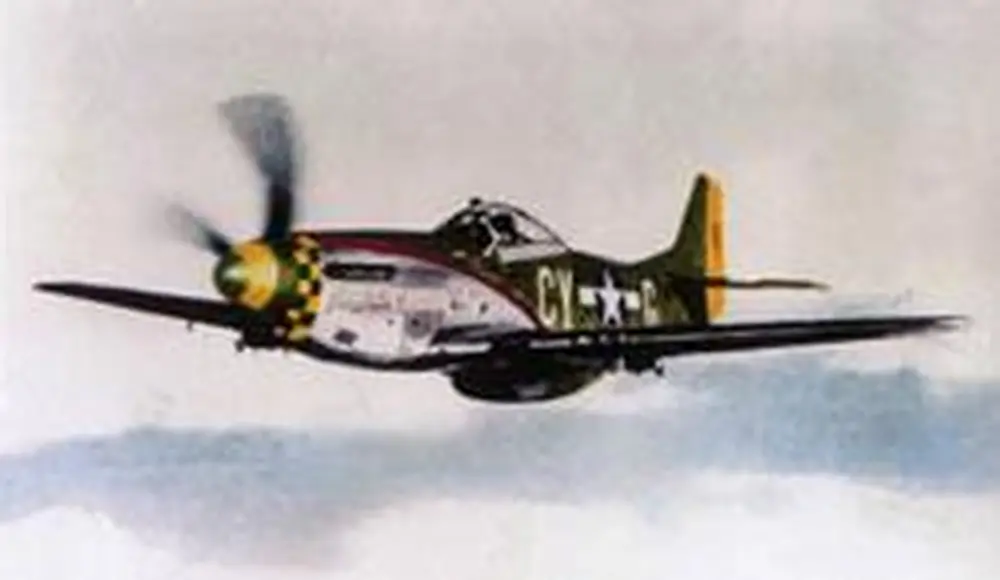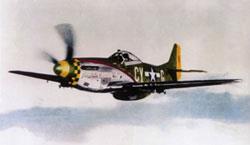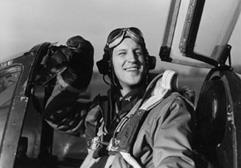

A few years ago, Maj. Gen. Edward Giller (Ret.) would have been surprised to see even a color photograph of one of his old World War II fighter planes, much less a magazine photo of one in flight more than 60 years after the war. A couple months ago, however, Warbird Digest published a recent photo of a P-51D buzzing along with his identification letters. It was the same color, and, true to form, it even had “Millie G”—in reference to his wife, Mildred—painted behind the propeller, just below the exhaust manifold.
This wasn’t actually one of Giller’s planes, but it was an exact replica built a few years ago by airplane enthusiasts in North Dakota who modeled it after finding some original parts. The magazine took a photo after it was sold to a pilot in Oklahoma.
It’s a noteworthy event for the 90-year-old Giller, who resides in good health in Albuquerque, N. Mex., with his wife. The LAS graduate (BA ’40, MA ’48, PhD ’50, chemical engineering) has led a colorful military and civilian life that includes nuclear weapons research, UFO investigations, and arms control, but his time in the P-51 over Europe was pivotal in the trajectory of his career.
Giller, who grew up on a farm in Illinois, joined the Army Air Corps (forerunner to the Air Force) when war broke out. He went to England and served as commander of the 343rd Fighter Squadron in the 55th Fighter Group. The decorated pilot logged 115 combat missions, was wounded by flak, and shot down three German aircraft, including a rare downing of a jet.
The P-51, or Mustang, was ideal for combat over Europe, Giller says, partly because its design allowed it to counter German tactics of the time. The P-51 was credited with helping the Allies to gain air superiority over the Germans, and the model was later used by air forces for decades.
“In Germany, if you got on a fighter’s tail he would do what you call a split S, which is he turns upside down, and then he goes straight down, 400 or 500 miles an hour. You can’t do that in a P-38,” he says, referring to a heavier, two-engine American fighter of the time. “But the P-51 has a nice thin wing, so when the Germans did that, we just turned upside down and went with him. So that leveled that part of the playing field.”
And, unlike the P-38, which left two contrails, the single-engine P-51 only left one contrail, just like the German fighters of the time. That meant enemy forces often weren’t sure whether they were friend or foe until the Americans were close.

The same problem applied to their friends, however, as the P-51s resembled German Bf 109s. So one day Giller and a friend flew up in their P-51s to pose for a British bomber outfitted with camera gear. The photos were distributed to bomber pilots so they could distinguish the Americans from Germans (Giller also uses the photo on his business card).
After the war, Giller returned to LAS under the Air Force Institute of Technology Program. He studied chemical engineering again, this time under the late Professor Harry Drickamer. Giller wanted to earn a doctorate, but his orders only allowed time to earn a master’s degree. To plead his case, Giller drove to nearby Chanute Air Force Base, boarded a B-25 bomber and flew to the Pentagon (he needed four hours of flight time a month anyway to get his flight pay).
He was pleasantly surprised to run into his old buddy who flew with him the day their P-51s were photographed, and who was now on staff at the Pentagon. His friend promised to look into it, but Giller called him back when orders came to leave school for Dayton, Ohio.
“I said, ‘Hey, are you going to let me stay in school?’” Giller recalls. “He says, ‘Wait a minute. The general is going by. I’ll ask him.’ There’s a muffled tone on the telephone, and then he says, ‘You can stay.’”
Giller laughs as he recalls that the next newsletter from Maxwell Field in Alabama, which handled his study program, announced that students were not permitted to approach the Pentagon without first going through headquarters.
“The moral of the story is, ‘Do what you gotta do and ask questions later,’” Giller says.
After his doctorate, Giller went on to perform a variety of duties in research in development, including studying thermal radiation from nuclear blasts and working at the Central Intelligence Agency, where he was deputy director of a small research branch that developed various weapons and tools for psychological warfare and eavesdropping.
“It was the James Bond department. We weren’t as good as he was,” Giller quips. “I learned a lot of things that don’t work.”
In 1966, with the government under public pressure, Giller, then a brigadier general in the Air Force, initiated a partnership with the University of Colorado to investigate reported UFO sightings. The findings, commonly called the Condon Report for the scientist who headed the investigation, concluded there was no extraterrestrial involvement in the sightings. As a result, in 1969 the Air Force terminated Project Blue Book, its program to investigate UFOs.
Later, Giller directed the Division of Military Application at the Atomic Energy Commission (now part of the Department of Energy), which conducted nuclear tests in Nevada and the Pacific Ocean. During his tenure he attended the largest underground bomb test in the United States—400 times more powerful than Hiroshima—on Amchitka, an uninhabited island near the end of the Aleutian Chain.
After his retirement from the Air Force in 1972, Giller went on to work as a civilian arms control negotiator in Europe. He worked a few years after that as a consultant, but in 1990, he and Mildred decided they’d had enough of Washington, and retired to Albuquerque to “watch the blue sky,” he says.
As for the P-51, of the estimated 13,000 that were built during the war, fewer than 300 remain, according to the website mustangsmustangs.com, which traces the planes. They exist as novelties, with about 150 still flyable. Giller has been quoted saying it’s better to see them flying than “sitting on a pole in a museum somewhere.”
Giller’s original planes are almost all gone. He flew eight fighters in the war, including four P-38s and four P-51s, all of which bore the name Millie G. Giller last saw a genuine Millie G just before he returned to the United States after the war, when he spotted one of his P-51s sitting forlornly on a German airfield.
According to Dick Phillips, however, a P-51 historian in Minnesota, that plane still had some life in it. You might even call it immortal, as it exists in drawings and eventually served as the model for the paint design on the replica that appeared in Warbird Digest (Phillips provided the builders with its color scheme).
In 1946, it was sold to Sweden. From there the P-51 changed hands and paint jobs several times and now rests prominently—on a pole—at San Isidro Air Force Base in the Dominican Republic after serving the Caribbean nation’s air force for almost 30 years.


